The restoration of "Playtime"
|
Read more
at in70mm.com The 70mm Newsletter |
| Written by: Jean-Rene FAILLOT. "Playtime" Project Manager for Arane/Guilliver Labs, Paris, France. Translated from French by Julie Theodore. Editorial assistance: Paul Rayton | Date: April 18, 2004 |
|
1967 I saw “Playtime” for the first time at the Empire Cinerama of Paris, avenue Wagram; I was 19. It was beautiful, it was big, huge...but I did not understand anything. 1970 My first job. It was in the production company that had produced Jacques Tati’s first movies, and there I watched (in secret), with some friends, his “Jour de Fetê” with a 16mm projector. (All this to say that somehow I evolved amid the universe of Jacques Tati’s movies and I certainly did not expect that some 30 years later, I would find myself in charge of the technical restoration of the images of one of the rare 65mm French films which is, moreover, one of Jacques Tati’s movies!) |
Further
in 70mm reading: Playtime bits Restoration (French) German Version Internet link: Les films de Mon Oncle Cannes 2003 The DVD More DVD |
1997 |
|
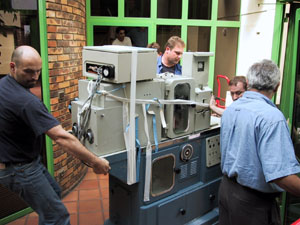 During the making of the credits of her movie “Le Comptoir de Marie”, I met Sophie Tatichieff. I showed her a few 70mm machines
that I had acquired in Kiev, in exchange for some film, and also the small 70mm laboratory (GULLIVER lab) created in 1994/95; obviously the subject of
“Playtime” came up, and a potential preservation of the original film. Eventually it was decided to see whether it could be done During the making of the credits of her movie “Le Comptoir de Marie”, I met Sophie Tatichieff. I showed her a few 70mm machines
that I had acquired in Kiev, in exchange for some film, and also the small 70mm laboratory (GULLIVER lab) created in 1994/95; obviously the subject of
“Playtime” came up, and a potential preservation of the original film. Eventually it was decided to see whether it could be done |
|
June 15th 1998 |
|
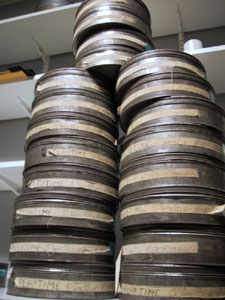 I saw about forty 70mm boxes (some 300, some 600 meters) come in; among those are about twenty boxes of
300m. size, quite rusty, but identified as being the original film. I expected the worst. So first, I began inspecting the condition of the film on a light table. I had many emotions and feelings, sitting in front of those large 65mm frames that compose
Jacques Tati’s masterpiece. Surprisingly, the film was not as damaged as I imagined, especially considering its age and the curious episodes of its conservation over the years. I saw about forty 70mm boxes (some 300, some 600 meters) come in; among those are about twenty boxes of
300m. size, quite rusty, but identified as being the original film. I expected the worst. So first, I began inspecting the condition of the film on a light table. I had many emotions and feelings, sitting in front of those large 65mm frames that compose
Jacques Tati’s masterpiece. Surprisingly, the film was not as damaged as I imagined, especially considering its age and the curious episodes of its conservation over the years. |
|
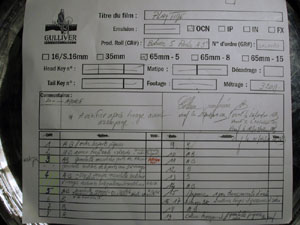 On June 26th, 1998, I sent Sophie a first report about the film: On June 26th, 1998, I sent Sophie a first report about the film:The good news: - no suspicious odor of vinegar - no trace of shifting of colors - it’s not alarmingly warped - there is no shrinking of the perforations (checking with a ruler) |
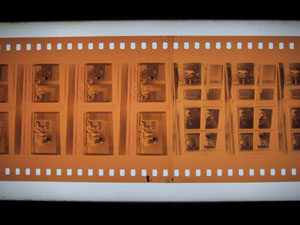 However there are: However there are:- lots of scratches and long lines on both support and emulsion sides - lots of stains from unknown origins (glue? solvent? development?) - about twelve splices are really in a bad shape but repairable - about 10 sequences are apparently internegative which quality-clashes with the original (they are soft, grainy and show photographed dust) - images missing in various places, mostly at the beginning and/or end of sequences, but also in middle of sequences (fortunately, never more than 3 successive frames) - about half a dozen sequences are more or less damaged and repaired with tape. |
|
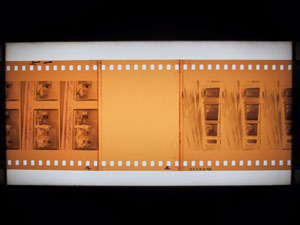 There
was one funny (to me) detail: the annotations of date of the different film
cuts, requested by Jacques Tati at that time, and written in black ink on the leaders. There
was one funny (to me) detail: the annotations of date of the different film
cuts, requested by Jacques Tati at that time, and written in black ink on the leaders.I asked to see the existing interpositive security elements. I received them on October 21, 1998, but they were useless. One of them was in the beginning stage of vinegar syndrome and the colors had turned, the other one -- which had not been wet-gate printed, was an unfortunately exact reflection of the defects and accidents of the original. In spite of that, I considered the project and the resources and wrote to Sophie that 90% of the problems could disappear with traditional processes, and the rest could be treated digitally. |
|
 Fortunately, I was conscious of the amount of work that was waiting for us. I say “us” because by the end of this year 1998, a small 70mm team was beginning to gather within the laboratory. Fortunately, I was conscious of the amount of work that was waiting for us. I say “us” because by the end of this year 1998, a small 70mm team was beginning to gather within the laboratory.Several years passed during which nothing material evolved concerning the restoration of "Playtime", except for the search for financial support. I would see Sophie occasionally, and she kept me informed about the evolution of the project. Ultimately, that delay turned out to be a good thing, because during that interval the Gulliver lab evolved further; acquiring a BHP printer 65/70 mm with wet-gate capability and adding 65mm negative development capability; later moving in to larger premises, setting up of a faster 70mm positive developer, acquisition of several 65mm peripheral tools and, not incidentally, further evolution in the quality of film stocks. |
|
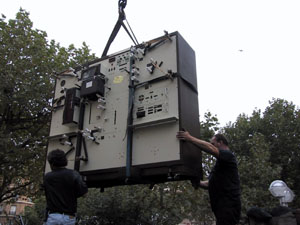 |
|
 |
|
February 2001 |
|
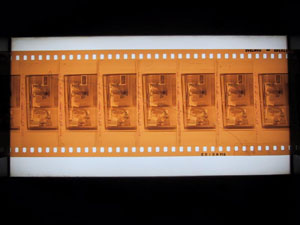 Sophie talked to me about Jérôme Deschamps (Les
Films de mon Oncle) for the first time and the growing possibility of re-starting the restoration. Sophie talked to me about Jérôme Deschamps (Les
Films de mon Oncle) for the first time and the growing possibility of re-starting the restoration.Around April 2001, I met Jérôme Deschamps and we talked again about the follow-up to the proposed restoration and particularly about reproducing the movie in its original version. Objective: the Cannes Film Festival in May 2002. I set up a work process to include the following steps: - try to find the original color-timing paper strips (short pieces with punched holes) - printing of a 70mm positive, on film Kodak 2383, of the spools 1A and 5A (300 m long spools), in immersion (wet gate) to see how the negative is reacting in all these machines. If the result of these spools (that are representative of the general shape of the film) is good, the remaining negative will pass well. I realized that I will be able to pass the negative only 4 or 5 times in the negative wiper and printer, otherwise I would be taking too many risks for the original. - Checking and repairing of the splices that need it - Strengthening of all splices with tape, on the sides only. |
|
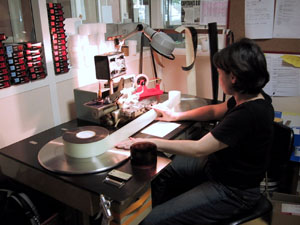 - Color balancing on color analyser
- Color balancing on color analyser- Projection of the new positive: (wonderful!) - Comparison with the old copy: it’s day and night - Where are those original short color-timing paper strips? I really need them! - Printing of an interpositive on film Kodak 5242 at the LAD [Laboratory Aim Density; the short 4-frame mini test chart seen on leaders of most reels of film, used by labs to verify development performance. - ed.] value - Printing of an internegative also on 5242 at the LAD value - Printing on film Kodak 2383 of a positive of this internegative - Comparative projection of the positive from the original and of the positive from the internegative: same result; beautiful. I did several comparative projections of the positives with different people (a screen test) to be sure that I was going in the right direction, and that confirmed my choice. Now we needed to work on the entire negative. In spite of all the searching, it was finally impossible to find the original short color-timing strips. So we had to start the color balancing from the beginning. |
|
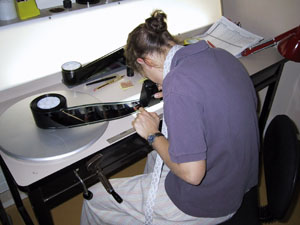 From June 24 to October 25, 2001, we were grading, frame by frame on the color analyser with a pre-color balance for the 17 other spools. It was difficult because the old negative color “mask” [the
orangeish-color “background” tint used in the Eastmancolor negative process for better print colors --ed.] reacted strangely with the video of the color analyser. I calculated several special default color level sttings for the printer, which was not easy because I had few elements to balance, and knew that I could only attempt very few positive test printings because of the fragility of the negative. So I could not make a definitive balance from the original negative. We would have to finish the balance on the internegative, after we re-incorporated the digital restorations. From June 24 to October 25, 2001, we were grading, frame by frame on the color analyser with a pre-color balance for the 17 other spools. It was difficult because the old negative color “mask” [the
orangeish-color “background” tint used in the Eastmancolor negative process for better print colors --ed.] reacted strangely with the video of the color analyser. I calculated several special default color level sttings for the printer, which was not easy because I had few elements to balance, and knew that I could only attempt very few positive test printings because of the fragility of the negative. So I could not make a definitive balance from the original negative. We would have to finish the balance on the internegative, after we re-incorporated the digital restorations. |
|
September 2001 |
|
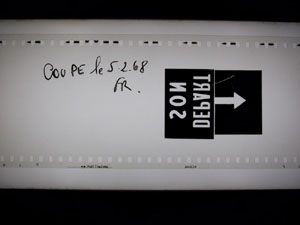 amorce
bob 9 amorce
bob 9Final meeting with all the principals involved in the restoration, and all the team of Arane/Gulliver to set up the calendar/countdown. Confirmed deadline: May 2002 for the Cannes Film Festival. I also received the confirmation that some sequences would be lengthened to be put at their original length. Thoughts about digital for the sequences to be repaired and lengthned: |
|
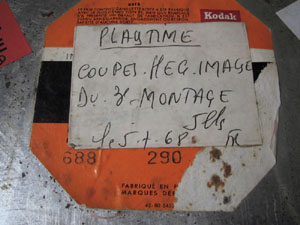 couvercle
de boite couvercle
de boiteI had two options for the scan: work from the negative, or the interpositive. Given the fact that the scan would take place in L.A., if the scan was made from the original the negative, we needed to make a security interpositive anyway. In 65mm, the two scan tests, negative and interpositive, were of the same quality but from the interpositive printed in immersion, there was nothing to clean after; and it was faster and cheaper. We chose the option: scan 4K from the interpositive and shoot 4K in 10 bits log, all that in reference to the standard printing chemistry, so that the sequences digitally restored would match the natural-developed restored images the best way possible. All these tests are so long and involved!! |
|
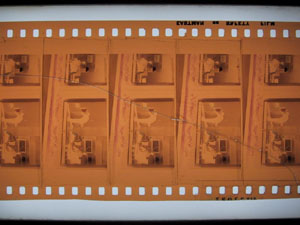 dechirure
neg 1 dechirure
neg 1Overall, concerning the digital: scanned from the interpositive 5242 printed in immersion, shot with a Ciné 3 on 5242. That gave me a new “original negative” that I could directly put in the final internegative after I printed a security interpositive, and it would be correctly balanced so that it will intercut with the interpositive of the rest of the film. I kept on working on the positives from the original negative, watching in projection step-by-step after the spools are printed in order to catch any defects that will have to be repaired digitally. The hardest during this phase was to stay focused on the technical problems of the image whereas I was also discovering, one by one, all the gags of the movie. In order to minimize that situation, some of us watch the projections together, but it is still such a pleasure for all of us that this period of work lasts longer than it was planned to. |
|
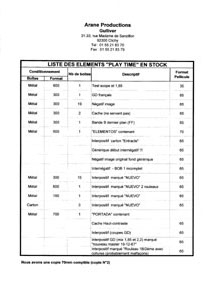 elements
recus elements
recusAfter each spool projection, we observed on the negative via the positive, the stains and other development defects and confer on what else needs to be done. A large amount of diverse stains have been eliminated thanks to silver polisher (it’s an old lab trick). Another problem arose: the first part of the movie takes place in a décor composed of grey walls. I was seeking to be as neutral as possible, which was very difficult, first because during the shooting they used an arc projector with color temperatures not sufficiently accurate for those neutral greys. And then I realized that our 70mm printer did not have a very good source of light, due to the fact that additive lights of the printer were the same ones used for the 35mm printers -- with only the addition of anamorphic lenses to expand the light beams for the 70mm aperture; the result was that all the unavoidable light source defects are doubled. I corrected the light problem with a system as old as photography: I created compensations in the printer. |
|
December 2001 / January 2002 |
|
 Some duplicate negatives and original trims (not-used pieces) were brought to me in order to do first positive 35mm reductions of the added or lengthened sequences. These would be re-incorporated in the 35mm copy that we used as work copy for the re-editing of image and sound. Meanwhile, I noticed on the optical printer that the format of the image was close to the 1.85 ratio. Some duplicate negatives and original trims (not-used pieces) were brought to me in order to do first positive 35mm reductions of the added or lengthened sequences. These would be re-incorporated in the 35mm copy that we used as work copy for the re-editing of image and sound. Meanwhile, I noticed on the optical printer that the format of the image was close to the 1.85 ratio.I measured precisely the image on the negative: 40.56mm x 23mm, that is a 1.7635 ratio, but as the 1.75 format no longer exists [except in special cases and archival films --ed.] in projection, I chose the 1.85 centering so that it would be possible to see the entire image left/right in projection with small black lines at the top and at the bottom. That is the reason why I made the 35mm internegative with this framing ratio. Doing that directly from the new 65mm interpositive allowed me to use spherical optics of very high quality on the reduction printer and to have the best possible working 35mm copies. |
|
January/February 2002 |
|
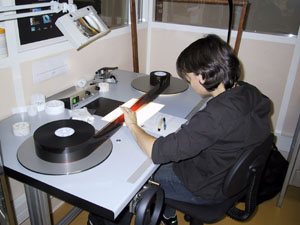 During January/February 2002, we balanced sequence-by-sequence, all the spools of negatives. After each print, the negative was again checked splice-by-splice
until the final print of the interpositive. During January/February 2002, we balanced sequence-by-sequence, all the spools of negatives. After each print, the negative was again checked splice-by-splice
until the final print of the interpositive. It took a very long time. The interpositives for the scan were sent to Imagica-USA in Los Angeles after we printed a check-print that we could check in projection. Obviously, we did some development tests of Imagica shoots at home in order for them to determine a setting for their shoot. I tried to have our development as consistent as possible, and, thanks to Imagica’s precision and to our steadiness, the work went smooth and fast. The story of the beginning credits is the following: it was impossible to find all the clouds that had been used as background for the credits. I had the entire title sequence in high contrast 65mm, but I only had constituting elements for the background. We did some tests, remodelling digitally these elements but the result was not good and, as a former credits maker, I found the original credits very touching with all their imperfections that let you see the difficulty of working on this format at that time (and still today!) So that is why I thought about leaving it as it was, and also to surprise some cinephiles who would believe, watching the credits, that the copy was not actually restored! |
|
March / April 2002 |
|
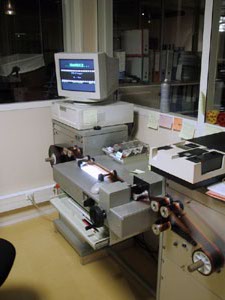 Mikros Image worked on the digital restoration of the damaged sequences and the one to be lengthened. Mikros Image worked on the digital restoration of the damaged sequences and the one to be lengthened.Then, everything began coming together swiftly. The projection at the Cannes Film Festival was planned for Sunday May 19, 2002 in the afternoon in the big auditorium, Louis Lumiere. The first shoots came back from L.A. and apparently there was a misunderstanding with the digital adjustments. It was not disastrous, but we felt it could be better. Gilles Gaillard from Mikros and I left for L.A., and during 4 intensive days we worked with a new Look Up Table [for digital color determinations --ed.] with the people from Imagica in order to obtain the kind of image we want. From April 20 to May 17, I worked non-stop on the checking, the integrating of the elements coming from L.A. and the printing of the two copies for Cannes. On May 3, I did a round trip to Cannes in a day, with the color balancer, to verify, on the big auditorium screen, some partial spools of the movie. The balance team had started the final balance at the beginning of April, but without the digital sequences. The last Imagica shoots arrived on May 10, 2002. On Friday May 17 at midnight, we got to Cannes with the two 70mm copies, where we delivered them on Saturday morning at 10:00 AM. The first public projection would be the very next day (Sunday), afternoon. |
|
|
Go: back
- top - back issues
- news index Updated 22-01-25 |
|
